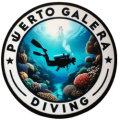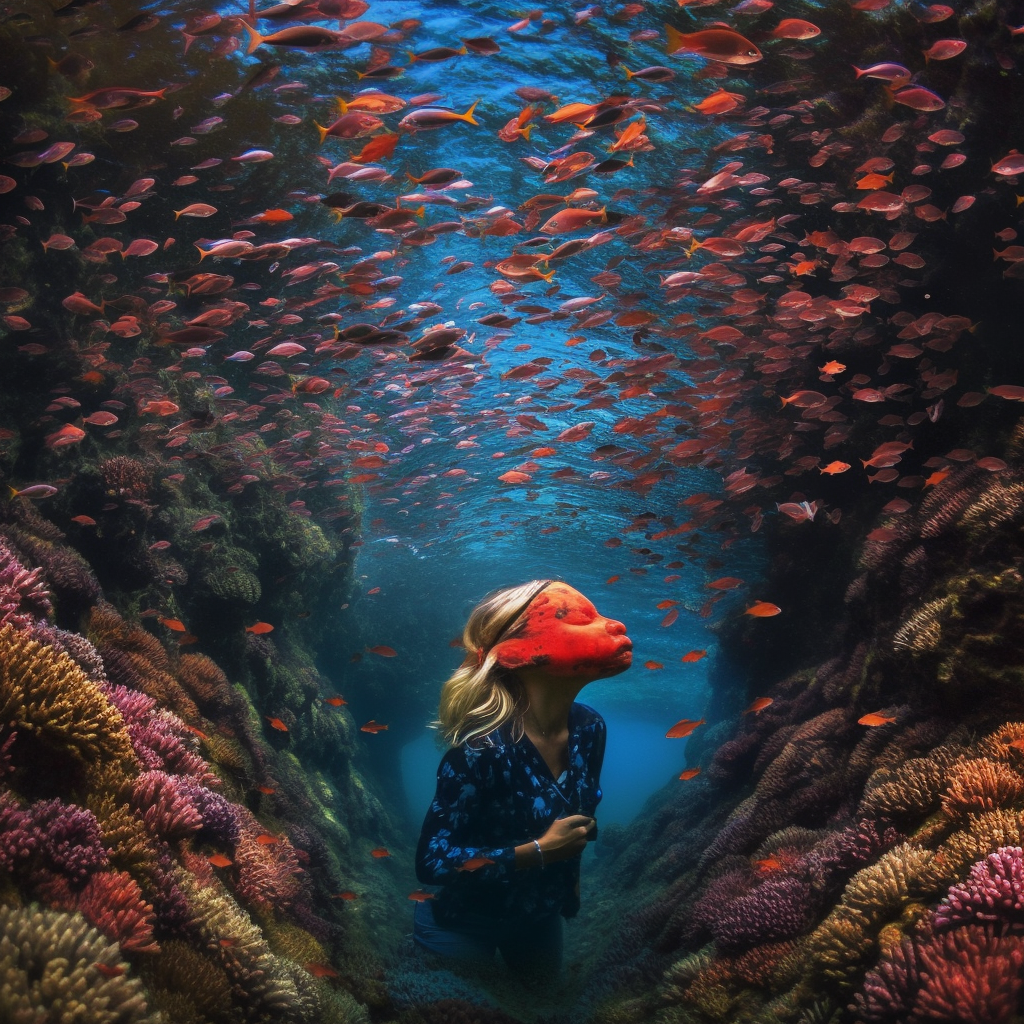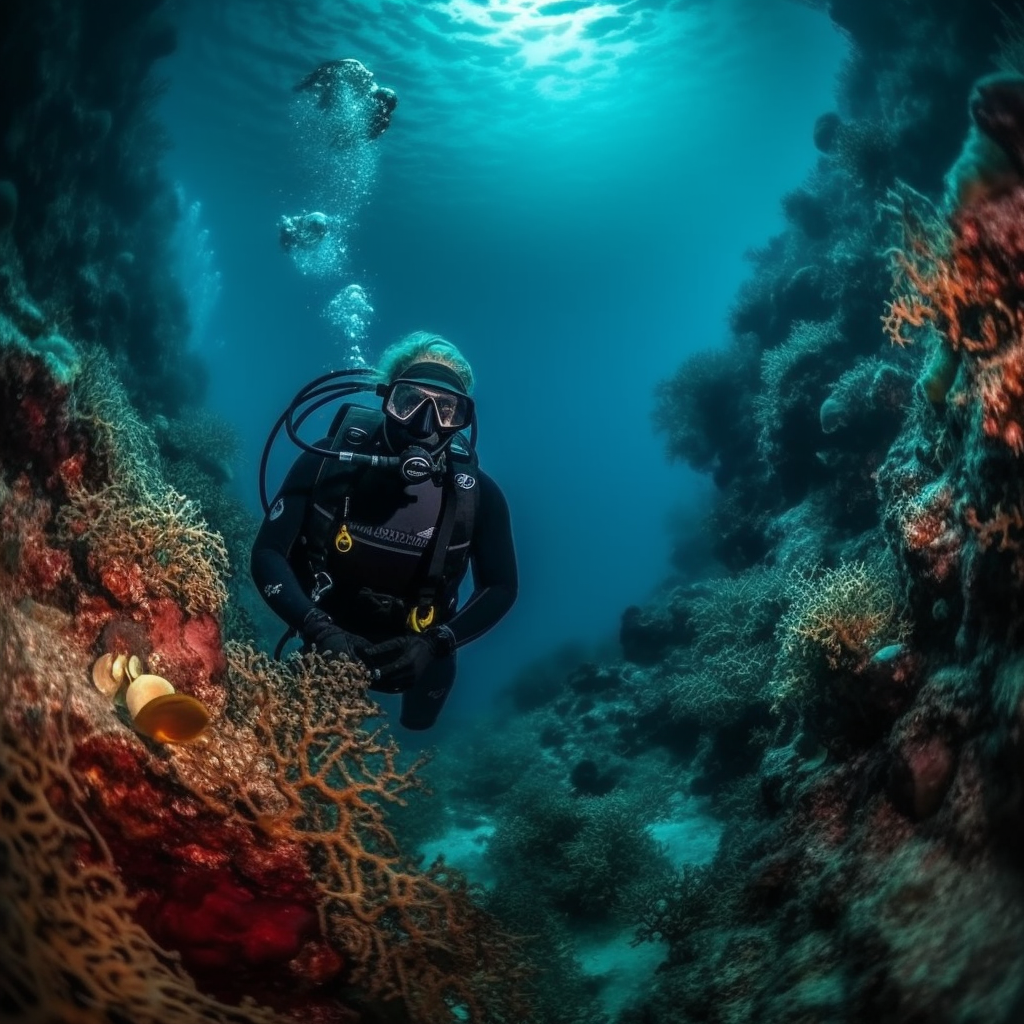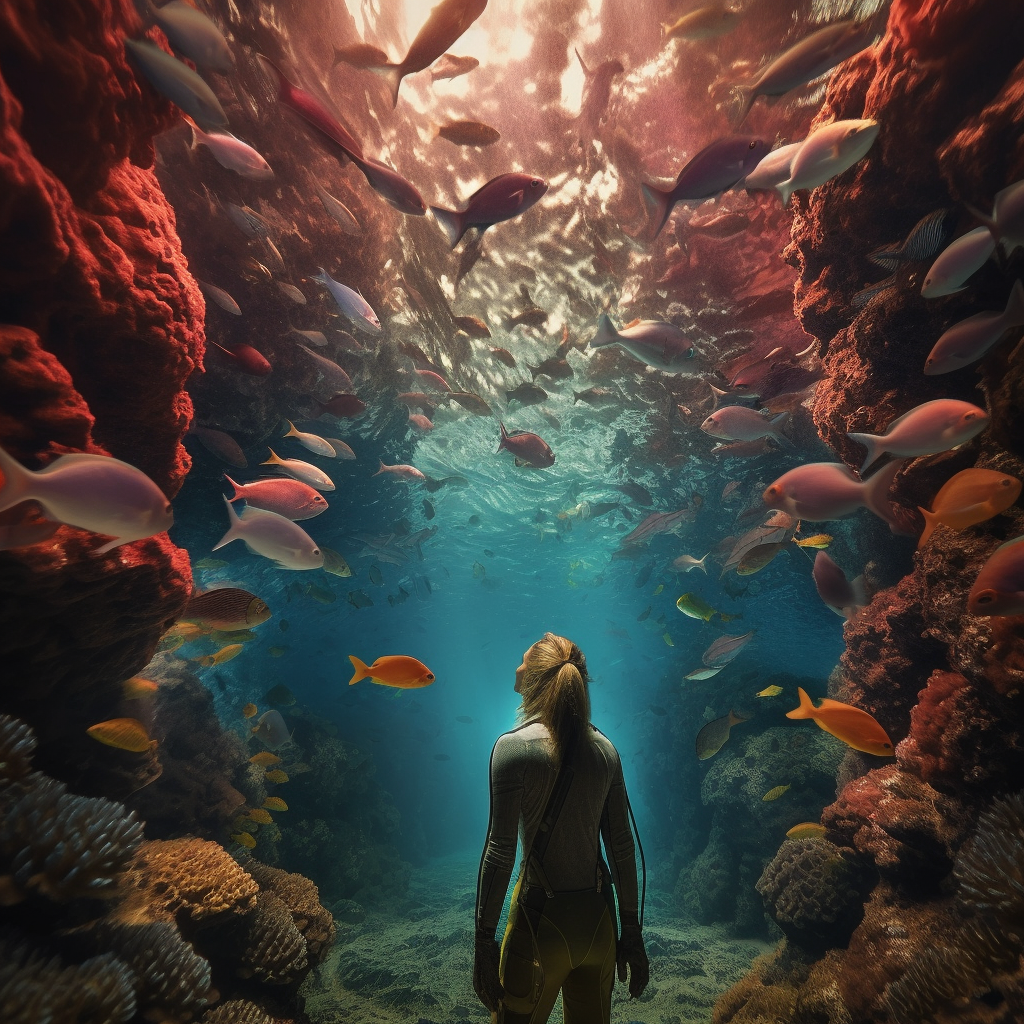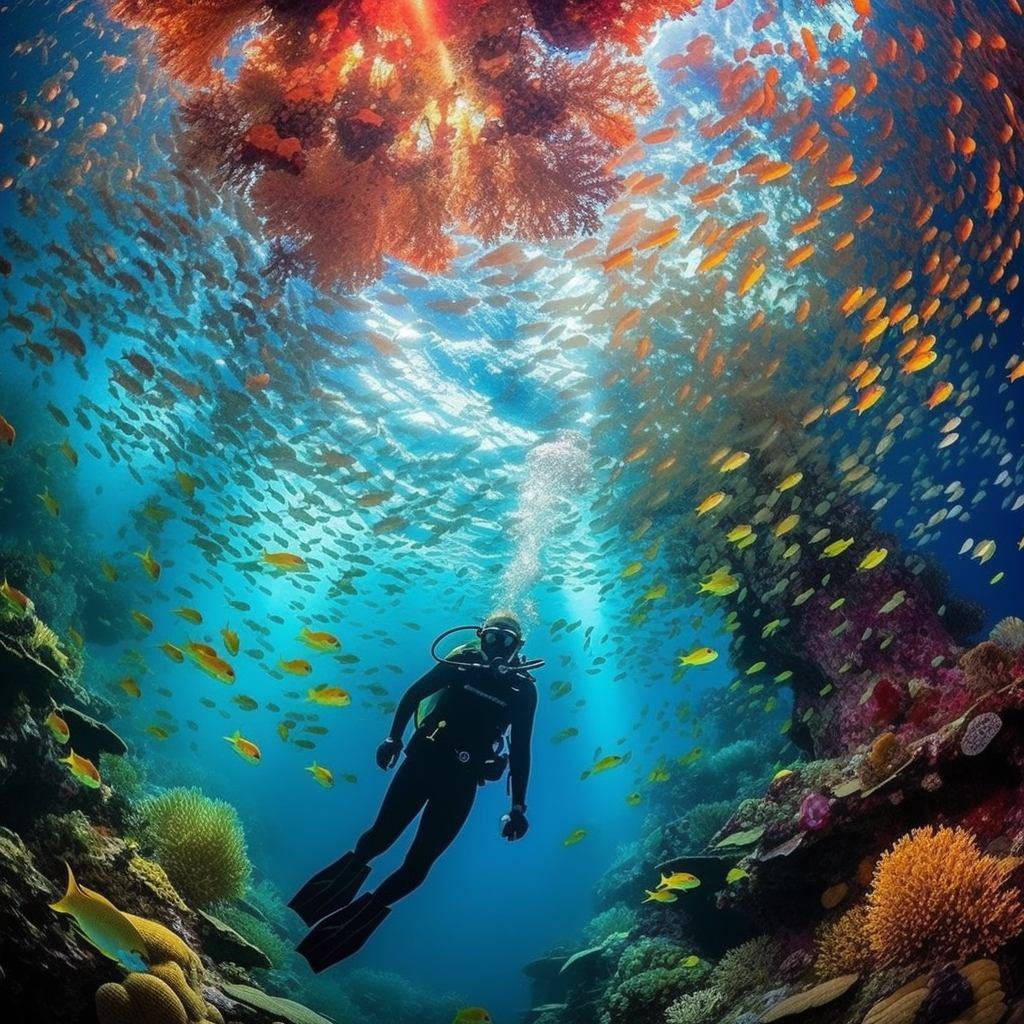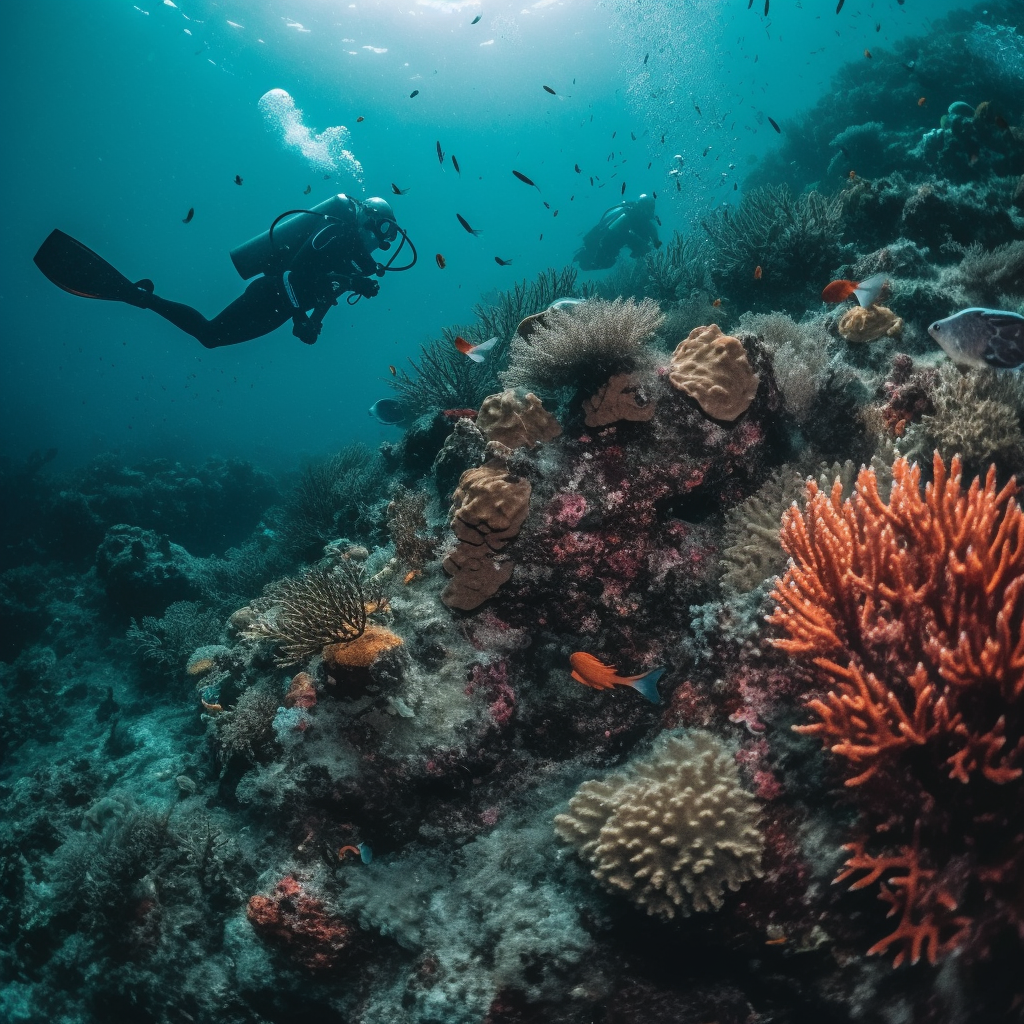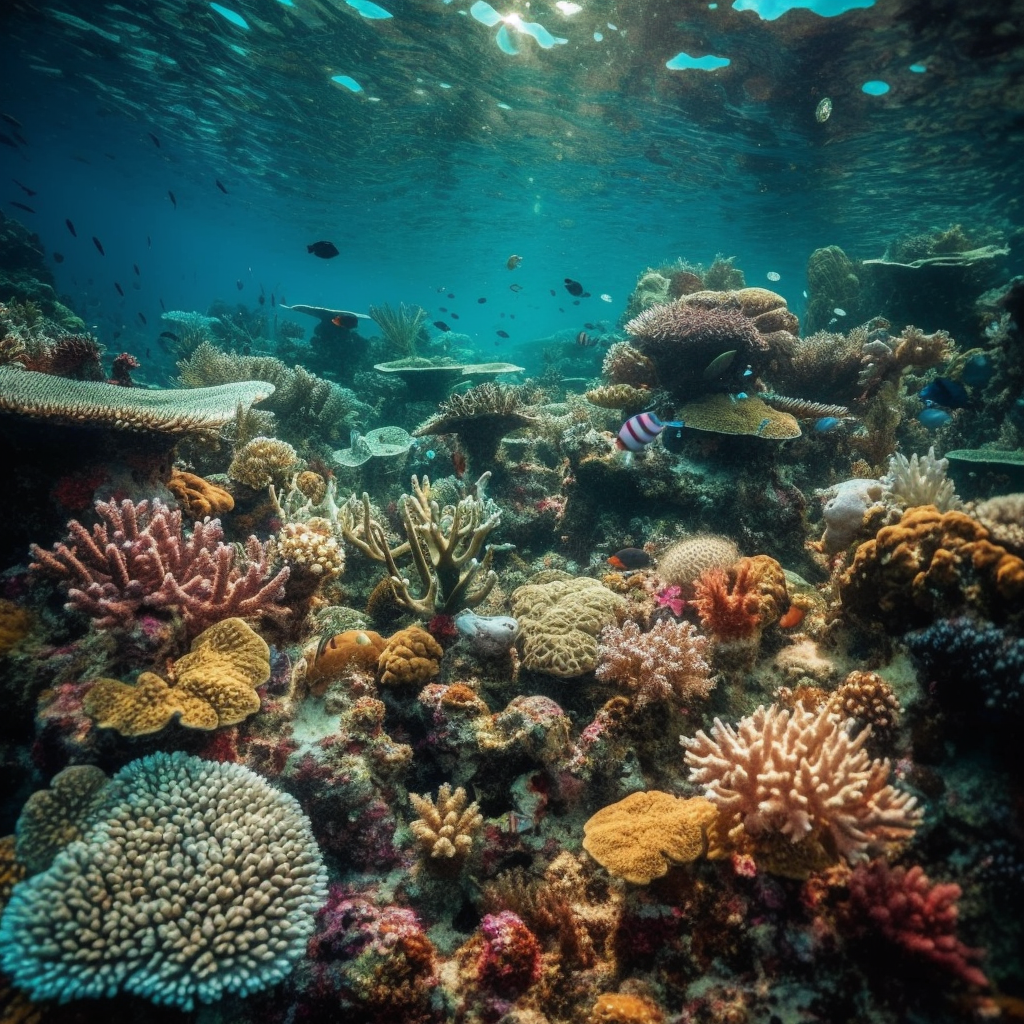Snorkeling and scuba diving are two popular activities that allow people to explore the underwater world. While they share some similarities, there are also significant differences between the two.
Snorkeling involves swimming on the surface of the water while wearing a mask and snorkel, which allows the person to breathe through a tube that extends above the water. This activity is relatively easy to learn and requires minimal equipment, making it accessible to people of all ages and skill levels. Snorkelers can observe marine life and coral reefs from above, but they are limited to the depth that they can reach and the amount of time they can spend underwater.
Scuba diving, on the other hand, involves wearing a full set of equipment, including a tank of compressed air, regulator, buoyancy compensator, and fins. This allows divers to explore deeper depths and stay underwater for longer periods of time. Scuba diving requires more training and certification than snorkeling, and divers must follow strict safety guidelines to avoid injury or illness. However, scuba diving offers a more immersive experience, allowing divers to get up close and personal with marine life and explore underwater caves and shipwrecks.
Defining Snorkeling and Scuba Diving
Definition of Snorkeling
Snorkeling is a recreational activity that involves swimming on the surface of the water while wearing a mask and a snorkel. The snorkel allows the person to breathe through a tube that extends above the water’s surface, while the mask allows them to see underwater. Snorkeling is often done in shallow water, such as near a beach or a coral reef. It is a popular activity for people of all ages and skill levels.
Definition of Scuba Diving
Scuba diving, on the other hand, is a more advanced form of underwater exploration that involves the use of a self-contained underwater breathing apparatus (SCUBA). This equipment allows the diver to breathe underwater for extended periods of time, and to explore deeper and more remote underwater environments. Scuba diving requires specialized training and certification, and can be done in a variety of settings, including open water, caves, and wrecks.
While both snorkeling and scuba diving involve exploring the underwater world, there are several key differences between the two activities. Snorkeling is generally considered to be a more casual and accessible activity, while scuba diving requires more training, equipment, and preparation. Additionally, scuba diving allows for more in-depth exploration of the underwater environment, while snorkeling is limited to the surface.
Overall, the choice between snorkeling and scuba diving will depend on a person’s interests, skill level, and goals. Snorkeling is a great way to experience the beauty of the underwater world without the need for specialized equipment or training, while scuba diving offers a more immersive and adventurous experience for those who are willing to invest the time and effort to learn.
Equipment Differences
Snorkeling Equipment
Snorkeling requires minimal equipment compared to scuba diving. The most essential pieces of equipment for snorkeling are a mask, fins, and a snorkel. The mask allows the snorkeler to see underwater, while the fins help them swim more efficiently. The snorkel is a tube that allows the snorkeler to breathe while their face is submerged in the water.
Snorkeling masks are designed to fit snugly around the face, creating a seal that prevents water from entering the mask. They are made of a shatterproof material and have tempered glass lenses that are more durable than plastic lenses. Snorkeling fins are similar to swim fins but are longer and stiffer, allowing the snorkeler to move through the water with less effort. Snorkels come in different shapes and sizes, but the most common types are dry snorkels and semi-dry snorkels. Dry snorkels have a valve that prevents water from entering the snorkel, while semi-dry snorkels have a splash guard that reduces the amount of water that enters the snorkel.
Scuba Diving Equipment
Scuba diving requires more equipment than snorkeling. The most essential pieces of equipment for scuba diving are a mask, fins, a regulator, a mouthpiece, and a tank. The mask and fins are similar to those used in snorkeling, but the regulator and mouthpiece are used to breathe underwater. The regulator is a device that attaches to the tank and reduces the pressure of the air to a level that is safe for breathing. The mouthpiece is attached to the regulator and allows the diver to breathe in and out of the regulator.
Scuba diving masks are similar to snorkeling masks but have a few additional features, including a nose pocket that allows the diver to equalize the pressure in their ears and sinuses. Scuba diving fins are similar to snorkeling fins but are stiffer and have a larger surface area, allowing the diver to move more efficiently through the water. In addition to the regulator and mouthpiece, scuba diving also requires a tank, which is a pressurized gas tank that contains either compressed air or a mixture of gases. Scuba divers also wear a buoyancy control device (BCD), which is a vest that allows them to control their buoyancy underwater. Diving suits, including wetsuits and drysuits, are also essential for scuba diving to protect the diver from cold water temperatures and to provide buoyancy control.
Other optional scuba diving equipment includes dive computers, which are devices that measure the depth and time of the dive and calculate the decompression stops required to safely ascend to the surface. Divers may also use a compass to navigate underwater, and underwater cameras to capture images and videos of marine life.
Overall, scuba diving requires more equipment than snorkeling, and the equipment used in scuba diving is more complex. However, with the proper training and equipment, scuba diving can provide a more immersive and exciting underwater experience.
Engagement with the Marine Environment
When it comes to experiencing the marine environment, both snorkeling and scuba diving offer unique opportunities to explore the underwater world. However, the experience of engaging with the marine environment differs between the two activities.
Snorkeling Experience
Snorkeling is a surface-level activity that allows individuals to observe the marine life from above. Snorkelers use a mask and a snorkel to breathe while swimming on the surface of the water. This activity is ideal for those who want to explore the underwater world without the need for specialized training or equipment.
Snorkeling is a popular activity for those who want to see coral reefs, rocks, and underwater caves. It is also a great way to observe marine life in their natural habitat, such as colorful fish, sea turtles, and dolphins. Snorkeling is a non-invasive activity that allows individuals to observe the marine environment without disturbing the natural habitat.
Scuba Diving Experience
Scuba diving, on the other hand, allows individuals to explore the underwater world in a more immersive way. Scuba divers use specialized equipment, including a tank of compressed air, to breathe while exploring the marine environment. This activity requires specialized training and certification to ensure the safety of the diver.
Scuba diving offers the opportunity to explore the marine environment in greater detail, including deeper reefs and underwater caves. Scuba divers can also observe marine life up close, such as sharks, stingrays, and octopuses. Additionally, scuba diving allows individuals to participate in underwater sports, such as underwater welding and photography.
In conclusion, both snorkeling and scuba diving offer unique opportunities to engage with the marine environment. Snorkeling is a surface-level activity that allows individuals to observe the marine life from above, while scuba diving offers a more immersive experience that allows individuals to explore the underwater world in greater detail.
Safety and Risks
Safety in Snorkeling
Snorkeling is a relatively safe water activity. However, it is not entirely risk-free. The most common risk associated with snorkeling is drowning, which can occur due to various reasons such as exhaustion, currents, dehydration, and hyperventilation. To ensure safety while snorkeling, it is essential to follow proper safety procedures, such as:
- Always snorkel with a buddy or in a group.
- Do not snorkel in areas with strong currents or waves.
- Stay within your physical limits and do not push yourself beyond your capabilities.
- Keep a close eye on your surroundings and avoid getting too close to rocks or coral reefs.
- Wear a well-fitted snorkel mask and fins to ensure comfort and ease of movement.
- Stay hydrated and avoid hyperventilating before snorkeling.
- Be aware of your surroundings and do not touch or disturb marine life.
Safety in Scuba Diving
Scuba diving is a more complex and potentially hazardous activity than snorkeling. Proper training and certification are essential to ensure safety while scuba diving. The risks associated with scuba diving include decompression sickness, nitrogen narcosis, drowning, and other injuries related to ambient pressure. To minimize the risk of injury, it is essential to follow proper safety procedures, such as:
- Always dive with a buddy and stay within the limits of your training and experience.
- Check your equipment before diving and maintain it properly.
- Monitor your air supply and pressure gauge regularly.
- Follow proper ascent and descent procedures to avoid decompression sickness.
- Avoid diving beyond your physical limits and do not push yourself beyond your capabilities.
- Stay hydrated and avoid alcohol consumption before diving.
- Be aware of your surroundings and avoid touching or disturbing marine life.
In summary, both snorkeling and scuba diving have their own set of risks and safety considerations. By following proper safety procedures and staying within your limits, you can enjoy these activities safely and without incident.
Training and Certification
Snorkeling Training
Snorkeling is a relatively simple activity that requires minimal training. However, it is recommended that individuals interested in snorkeling have basic swimming skills and are comfortable in the water. Snorkeling training can provide individuals with knowledge about different types of equipment and techniques to improve their experience.
While there is no formal certification process for snorkeling, some tour operators or resorts may require individuals to complete a brief training session before allowing them to participate in snorkeling activities.
Scuba Diving Training
Scuba diving requires extensive training and certification to ensure the safety of the diver. The minimum age for scuba diving certification varies by country and organization, but is typically around 10-12 years old.
Diver certification courses typically consist of a combination of classroom instruction, pool training, and open water dives. The most common certification is the Open Water Diver certification, which allows individuals to dive to a maximum depth of 60 feet.
Before enrolling in a certification course, individuals must have basic swimming skills and be comfortable in the water. Some organizations may require individuals to complete a medical questionnaire before participating in scuba diving activities.
It is important to note that scuba diving certification is not a one-time process. Divers must continue to gain experience and complete additional training to advance their skills and certifications.
Techniques and Skills
Snorkeling Techniques
Snorkeling is a popular activity that involves swimming on the surface of the water while wearing a snorkel tube to breathe. Snorkeling requires minimal equipment and is relatively easy to learn. Some of the essential techniques and skills involved in snorkeling include:
- Breathing technique: Snorkelers must learn how to breathe through their snorkel tube without inhaling water. They should also learn how to clear their snorkel if water enters it.
- Time: Snorkelers must learn how to conserve their energy and stay afloat for extended periods.
- Weather conditions: Snorkeling is best done in calm and clear water conditions. Snorkelers should avoid strong currents or rough waves.
Scuba Diving Techniques
Scuba diving involves using self-contained underwater breathing apparatus (SCUBA) to breathe underwater. Scuba diving requires more equipment and training than snorkeling. Some of the essential techniques and skills involved in scuba diving include:
- Breathing technique: Scuba divers must learn how to breathe through a regulator, which delivers breathing gas mixture from a tank. They should also learn how to clear their regulator if water enters it.
- Time: Scuba divers must learn how to manage their air supply and stay within safe depths and time limits.
- Technique: Scuba divers must learn how to equalize their ears and mask as they descend and ascend.
- Skill level: Scuba diving requires more training and experience than snorkeling. Divers must learn how to manage buoyancy, navigate underwater, and handle emergency situations.
In summary, snorkeling and scuba diving require different techniques and skills. Snorkeling is relatively easy to learn and requires minimal equipment, while scuba diving requires more training and equipment. Both activities require proper breathing techniques, time management, and awareness of weather conditions.
Exploring Different Locations
Snorkeling Locations
Snorkeling is a low-risk activity that can be enjoyed by people of all ages and skill levels. It is an excellent way to explore shallow waters and observe marine life up close. Some popular snorkeling locations include:
- Coral Reefs: Coral reefs are home to a diverse range of marine life, including colorful fish, sea turtles, and other fascinating creatures. Snorkelers can explore the vibrant coral formations and observe the marine life that calls them home.
- Caves: Snorkeling in caves can be an exciting and unique experience. Many caves are located in shallow waters and are accessible to snorkelers. However, it is important to exercise caution when exploring caves, as they can be dark and have strong currents.
- Beaches: Many beaches around the world offer excellent snorkeling opportunities. Snorkelers can explore the shallow waters close to shore and observe a variety of marine life.
Scuba Diving Locations
Scuba diving allows divers to explore deeper waters and observe marine life that is not visible from the surface. It requires more preparation and training than snorkeling, but it can be a thrilling and rewarding experience. Some popular scuba diving locations include:
- Shipwrecks: Shipwrecks are fascinating underwater structures that provide a unique habitat for marine life. Scuba divers can explore the sunken ships and observe the marine life that has made them their home.
- Coral Reefs: Coral reefs are also popular scuba diving locations. Divers can explore the intricate coral formations and observe the diverse marine life that lives among them.
- Deep Ocean: For experienced divers, exploring the deep ocean can be an exciting and challenging adventure. However, it is important to note that diving at extreme depths requires specialized training and equipment.
Overall, both snorkeling and scuba diving offer unique opportunities to explore the underwater world. Snorkeling is a great way to observe marine life in shallow waters, while scuba diving allows divers to explore deeper waters and observe marine life that is not visible from the surface.
Practical Considerations
Duration of Snorkeling versus Scuba Diving
One of the most significant differences between snorkeling and scuba diving is the duration of the activity. Snorkeling is typically shorter than scuba diving. A typical snorkeling session lasts about 1-2 hours, while a scuba diving session can last up to several hours. This is because snorkelers only need to hold their breath while diving, while scuba divers use compressed air tanks to breathe underwater, which allows them to stay submerged for longer periods.
Cost Differences
Another practical consideration when it comes to snorkeling versus scuba diving is the cost. Snorkeling is generally less expensive than scuba diving. Snorkelers only need basic equipment, such as a mask, snorkel, and fins, which can be rented at most beach resorts. Scuba diving, on the other hand, requires more expensive gear, including a wetsuit, regulator, air tank, and exposure protection. Additionally, scuba diving courses and certifications can be costly, which can add to the overall expense.
Overall, the cost of snorkeling is much lower than scuba diving, making it a more accessible activity for those on a budget.
Other Considerations
In addition to duration and cost, there are other practical considerations to keep in mind when choosing between snorkeling and scuba diving. For example, scuba divers need to take surface intervals between dives to allow their bodies to off-gas the excess nitrogen absorbed during the dive. Snorkelers, on the other hand, do not need to worry about decompression sickness.
Also, scuba divers create bubbles, which can disturb marine life and affect the underwater environment. Snorkelers do not have this issue.
Finally, some vacation destinations may offer jet ski tours that include snorkeling, but not scuba diving. Jet skis can be used to transport snorkelers to more remote locations, making it easier to access the best snorkeling spots.
In conclusion, when choosing between snorkeling and scuba diving, it is important to consider practical factors such as duration, cost, and other considerations. While snorkeling is generally less expensive and easier to access, scuba diving offers a more immersive experience and allows divers to explore deeper underwater environments.
Health Considerations
When it comes to health considerations, there are a few differences between snorkeling and scuba diving that should be taken into account.
One of the most significant risks associated with scuba diving is decompression sickness. This condition occurs when a diver ascends too quickly from a deep dive, and the nitrogen gas in their bloodstream forms bubbles that can cause joint pain, fatigue, and even paralysis. Snorkelers are less likely to experience decompression sickness, as they generally stay at shallower depths.
Another risk associated with scuba diving is nitrogen narcosis, which occurs when divers breathe in compressed air at depth. This can cause a feeling of euphoria or confusion, which can impair judgment and increase the risk of accidents. Snorkelers are less likely to experience nitrogen narcosis, as they do not breathe compressed air.
Oxygen toxicity is another risk associated with scuba diving. This occurs when divers breathe in too much oxygen at depth, which can cause seizures, nausea, and other symptoms. Snorkelers are not at risk of oxygen toxicity, as they are not breathing compressed air.
It is important to note that both snorkeling and scuba diving can be physically demanding activities, and individuals with pre-existing medical conditions should consult with a doctor before participating. Additionally, individuals with ear infections or sinus problems should avoid diving until they have fully recovered.
In conclusion, while both snorkeling and scuba diving have their unique risks and considerations, it is important to prioritize safety and take the necessary precautions to ensure an enjoyable and healthy experience.
Conclusion
In conclusion, both snorkeling and scuba diving are popular underwater activities that allow individuals to explore the beauty of the marine environment. While both activities involve being in the water and observing marine life, there are significant differences between them.
Snorkeling is a simpler and more accessible activity that requires minimal equipment and training. It involves swimming on the surface of the water while wearing a mask, snorkel, and fins. Snorkelers can observe marine life from above and enjoy the clear view of the underwater world without the need for heavy equipment or specialized training.
On the other hand, scuba diving is a more complex and technical activity that requires specialized equipment and training. Scuba divers can explore deeper underwater environments and experience a more immersive and intimate interaction with marine life. However, scuba diving also carries more risks and requires more preparation and attention to safety.
Overall, the choice between snorkeling and scuba diving depends on the individual’s preferences, experience, and comfort level. While snorkeling is a great option for beginners or those who want a simpler and more relaxed experience, scuba diving offers a more exciting and challenging adventure for those who are willing to invest the time and effort into learning the necessary skills and techniques.

